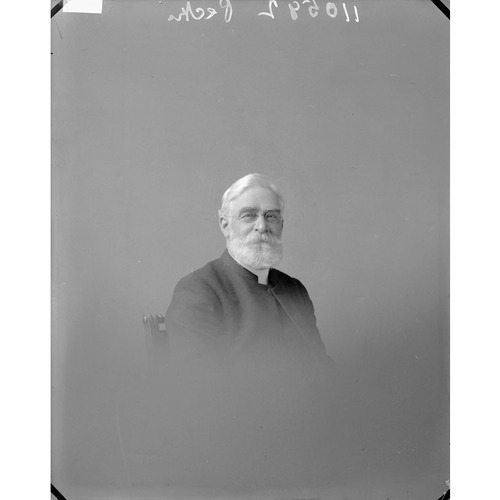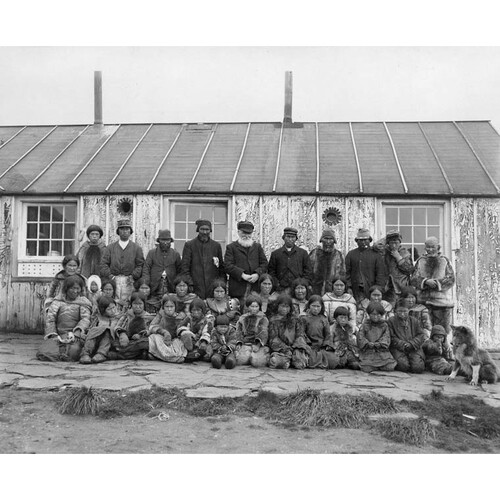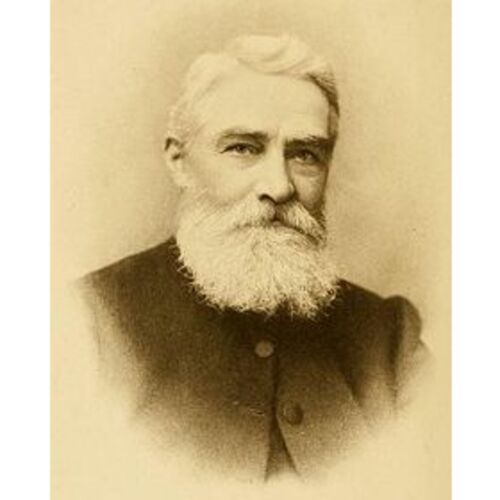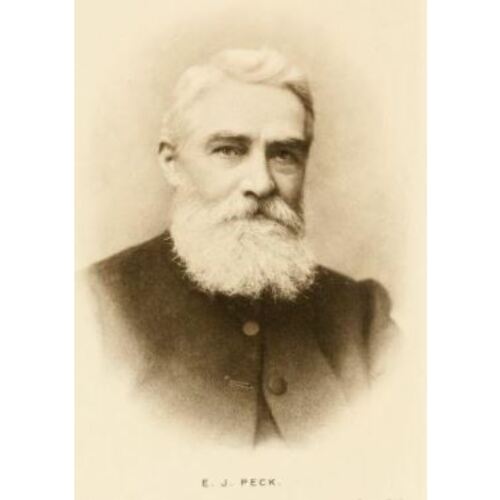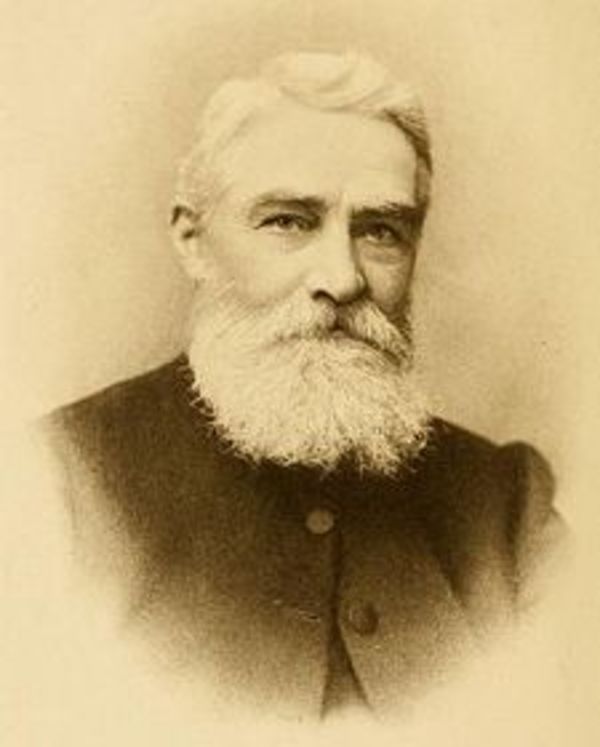
Source: Courtesy of Wikimedia Commons
PECK, EDMUND JAMES, Church of England missionary, founder of the first permanent mission on Baffin Island (Nunavut), translator, and author; b. 15 April 1850 in Rusholme, near Manchester, England, son of Thomas Peck and Clara Coleman; m. 29 April 1885 Sarah Ann Coleman in Greenwich (London), and they had three children; d. 10 Sept. 1924 in Ottawa.
Born into a devout family of modest means, who moved to Dublin in 1857, Edmund James Peck was the eldest of four children. When his mother died, he had to leave school and go to work in a printing plant though he was only ten years old; his father died three years later. Peck joined the Royal Navy in 1865 and served until 1875. He was a subaltern on numerous ships: the Ajax, Impregnable, Caledonia, Excellent, and then Hector, on which he found his calling and organized prayer groups. In 1875 he began studying Greek and theology at the Reading Preparatory Institution of the Church Missionary Society [see William Duncan*] in Islington (London). In the spring of 1876 Bishop John Horden* of the Anglican diocese of Moosonee was seeking a new recruit for his territory, which covered a good part of Hudson Bay and James Bay. Peck accepted the offer and left England in June 1876, as a missionary trained by the CMS, taking ship on the Prince of Wales. During the three-month voyage, he spent his time studying Inuktitut, the language of the Inuit, from textbooks published by the Moravian missionaries who were already established in Greenland and Labrador.
During his first stay among the Inuit (1876-84), Peck dedicated himself to several initiatives. On 1 Sept. 1876 he arrived in Moose Factory (Ont.), a Hudson’s Bay Company post where the CMS had established a mission in 1851. He left again almost at once for Little Whale River (Petite Rivière de la Baleine, Que.), another company post farther north, which the expedition reached on 24 October. Convinced that a knowledge of local languages was important for success in evangelization, Peck learned Inuktitut and Cree. At the bishop’s request, he even preached a sermon in Cree on 3 Feb. 1878 at Moose Factory, on the occasion of his ordination to the priesthood in the Church of England. Native catechists John and Moses Melucto, Edward Richard, and Adam Lucy helped him greatly in mastering these tongues, as he himself would acknowledge. He adopted the syllabic writing devised for the Ojibwa and Cree languages by Methodist missionary James Evans*, not to adapt it to Inuktitut – a task already accomplished by Horden and the Reverend Edwin Arthur Watkins – but to give new impetus to the work of religious instruction by making possible a wider circulation of the Gospel texts. In 1877 he distributed catechisms. His Portions of the Holy Scripture for the use of the Esquimaux on the northern and eastern shores of Hudson’s Bay was published in London in 1878. This first volume was followed in 1881 by Portions of the Book of Common Prayer: together with hymns, addresses, etc., for the use of the Eskimo of Hudson’s Bay and by St. Luke’s Gospel translated into the language of the Eskimo of Hudson’s Bay. Peck’s stay ended in the summer of 1884 with a three-week journey of exploration (from 17 July to 10 August) that took him from Little Whale River to Fort Chimo (Kuujjuaq), where he embarked for England on 5 September.
Peck spent his second stay, from 1885 to 1892, addressing the first challenges. Based in Fort George (Que.), where the Little Whale River mission had been moved in 1886, he now began frequent trips to the surrounding camps to carry out his work as an evangelist. His personal life was also full. He had married while in England, and his three children were born (in 1886, 1889, and 1891) after he returned to live among the Inuit. The missionary had to cut short his stay because of the ill-health of his wife, who found it hard to cope with the isolation.
During his period of rest in England, Peck, who since 1892 had been thinking of extending the range of his mission, found a way of reaching Cumberland Sound free of charge. In 1894 a Scottish shipowner, Crawford Noble, who owned a whaling station in southern Baffin Island, provided passage for him and lay missionary Joseph Calder Parker, on the Alert. This was a providential turn of events for Peck, for it finally enabled him to make contact with Inuit who had not yet been evangelized. He and Parker founded the first Anglican mission on Baffin Island on 21 Aug. 1894. The first church, built on Blacklead Island (then home to 171 Inuit), was made of sealskin. Between 1894 and 1905, with other missionaries of the CMS (Edgar William Tyler Greenshield, Julian William Bilby, Charles George Sampson), Peck paid four visits to Cumberland Sound, in 1894-96, 1897-99, 1900-2, and 1903-5. He also made many trips to the neighbouring regions (including Frobisher Bay and Kekerten Island). With the help of the Reverend William Gladstone Walton, he produced many more translations and transcriptions. In 1897 The four Gospels, translated into the language of the Eskimo of Hudson’s Bay was published in London, where Peck also had a more complete version of Portions of the Book of Common Prayer printed in 1900. Encouraged by the success of his evangelizing strategies, especially instruction in writing, he contemplated spreading Christianity much farther north.
At the request of Franz Boas*, Peck endeavoured, notwithstanding his missionary zeal, to collect and translate ethnographic data of high quality, including information about shamanism. Boas would publish this material in The Eskimo of Baffin Land and Hudson Bay, from notes collected by Capt. George Comer, Capt. James S. Mutch and Rev. E. J. Peck, a work of two volumes brought out in New York in 1901 and 1907. Peck completed his last transliterations of the Bible between 1895 and 1917. Since 1905 he had held the title of superintendent of missions in the Arctic. Although the CMS had decided in 1903 to withdraw gradually from Canada, Peck spent most of his time in fund-raising to ensure that the work of evangelization would continue on Baffin Island. His main residence was in Ottawa, but he still made a number of limited trips to Hudson Strait in 1909, 1911, 1917, 1918, and 1919, including visits to Lake Harbour (Kimmirut, Nunavut), Wakeham Bay, and Fort Chimo. In 1919 he wrote a grammar and dictionary in Inuktitut. The Eskimo grammar (Ottawa, 1919) would go through several reprintings, and the Eskimo-English dictionary would be published by Walton in Hamilton, Ont., in 1925. To mark the centenary of the CMS in Rupert’s Land in 1920, Peck wrote a pamphlet about the Inuit and the history of the evangelization in the Canadian eastern Arctic entitled The Eskimo: our brethren of the Arctic. Meant for a wide readership, it outlined Peck’s material and financial needs and was published around 1922, probably in Toronto.
Despite limited technical and financial resources, Edmund James Peck hoped, no matter what the cost, to find solutions to the problem of introducing Christianity among the nomadic Inuit. He remained particularly true to the principles of Henry Venn, the third secretary of the CMS. Thus in Baffin Island, and in what would later become Nunavik, Que., he always organized his catechistical methods around two main poles: the translation and rapid circulation of the Holy Scriptures and, in keeping with the Native Church Policy adopted by the CMS, the training of native converts and leaders. Peck often recruited shamans as the first Inuit ministers, notably the Meluctos, Peter Tulugaqjuaq, and Luke Qillaapik. His peers christened him “the apostle of the Inuit,” and the Inuit paid homage to him by naming him Uqammaq, “he who speaks well.”
In addition to the works cited above, Edmund James Peck published numerous articles in the Church Missionary Gleaner (Toronto) and the Moosonee and Keewatin Mailbag (Moosonee, Ont.).
Primary documents concerning Peck are preserved in the Univ. of Birmingham Library, Special Coll. (Birmingham, Eng.), the Church Missionary Soc. Arch., and the Anglican Church of Canada, General Synod Arch. (Toronto), M56/1 (Peck papers). The last collection includes the preliminary version of an autobiography as well as an unpublished biography prepared by Kenn Harper, “Uqarmat: the life of Reverend Edmund James Peck” and a copy of Peck’s marriage record. The LAC holds a microfilm copy of the Church Missionary Soc. records relating to Canada (MG 17, B2). Church of Jesus Christ of Latter-day Saints, Geneal. Soc., International geneal. index. Apostle to the Inuit; the journals and ethnographic notes of Edmund James Peck: the Baffin years, 1894-1905, ed. Frédéric Laugrand et al, (Toronto, forthcoming). Karen Evans, “Edmund James Peck: his contribution to Eskimo literacy and publishing,” Canadian Church Hist. Soc., Journal (Toronto), 26 (1984): 58-68. Kenn Harper, “The early development of Inuktitut syllabic orthography,” Inuit Studies (Quebec), 9 (1985): 141-62. Frédéric Laugrand, “‘Ni vainqueurs, ni vaincus’: les premières rencontres entre les chamanes inuit (angakkuit) et les missionnaires dans trois régions de l’Arctique canadien,” Anthropologie et Sociétés (Québec), 21 (1997): 99-123; “Premiers catéchismes et méthodes catéchistiques des missionnaires anglicans et oblats chez les Inuit de l’Arctique de l’Est (1852-1937),” CCHA, Études d’hist. religieuse, 64 (1998): 9-29; “Siqqitiqpuq: conversion et réception du christianisme par les Inuit de l’Arctique de l’Est canadien (1890-1940)” (thèse de phd, univ. Laval, Québec, 2000). Arthur Lewis, The life and work of the Rev. E. J. Peck among the Eskimos (New York, 1904).
Cite This Article
Frédéric Laugrand, “PECK, EDMUND JAMES,” in Dictionary of Canadian Biography, vol. 15, University of Toronto/Université Laval, 2003–, accessed December 28, 2025, https://www.biographi.ca/en/bio/peck_edmund_james_15E.html.
The citation above shows the format for footnotes and endnotes according to the Chicago manual of style (16th edition). Information to be used in other citation formats:
| Permalink: | https://www.biographi.ca/en/bio/peck_edmund_james_15E.html |
| Author of Article: | Frédéric Laugrand |
| Title of Article: | PECK, EDMUND JAMES |
| Publication Name: | Dictionary of Canadian Biography, vol. 15 |
| Publisher: | University of Toronto/Université Laval |
| Year of publication: | 2005 |
| Year of revision: | 2005 |
| Access Date: | December 28, 2025 |


